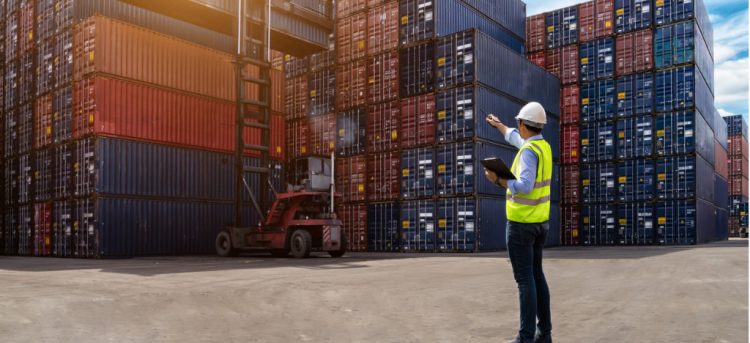Small business owners in the ecommerce and retail industries have been dealing with delayed delivery times since the pandemic began. But there are steps you can take today to improve the process and ease the pressure from your business. In this article, we cover how long you can expect shipping to take, why so many shipments are delayed, and what small business owners can do to handle these challenges.
How Long Is International Shipping Taking Right Now?
Retail business overseas delays are still taking place when compared to pre-pandemic days. Shipping from China used to take 40 days on average but increased to 70 days by the end of 2021. The Ocean Timeliness Indicator from Flexport recorded a high of a whopping 114 days.
According to the Global Supply Chain Pressure Index, shipping companies aren’t out of the woods yet — shipping times from several parts of the world into the U.S. are still lagging. Chinese and European ports are a major source of many of the delays, with China’s continued lockdowns contributing greatly. Furthermore, the cost of sending airfreight from the U.S. to Asia is pricier, which means you may pay more to get the items you need to sell.
Why Are Overseas Shipments Taking So Long?
There are many factors contributing to the shipping delays, like the fact that 95% of the trans-Pacific shipping industry is controlled by three alliances, which allowed them to hike up shipping costs. But the COVID-19 pandemic exacerbated the other issues and worsened the situation. Global ports were closed and there weren’t enough workers on hand because of the virus, so cargo ships got very backed up.
Most global shipping happens over the ocean. Thus, cargo ship delays, shipping container buildups, port closures, and labor shortages have caused major delays for many U.S. retailers trying to maintain their stock. Not to mention, it’s more expensive now to ship new products. The cost of shipping is seven times higher than it was prior to the pandemic, according to the International Monetary Fund.
Even Amazon isn’t immune to the impact from shipping delays. Between 15% and 23% of the company’s products were out of stock toward the end of 2021, CNN reported. However, small retailers without the resources of a huge corporation like Amazon are feeling the biggest impacts.
What Happens When a Supplier Fails To Deliver?
When there are late deliveries, retailers have to deal with the real-time consequences of supply chain disruptions and product shortages. A positive customer experience is vital for maintaining brand loyalty. According to a recent Oracle survey, more than half of consumers would switch brands after sought-after items were out of stock or delayed between one and three times. So, if a retail business encounters a late shipment, it might only take one out-of-stock item to convince customers to go elsewhere.
How Does a Retail Business Deal With Delayed Shipping?
Here are several moves retailers can make to lessen the stresses associated with supply chain delays and delayed shipping.
Adjust to new consumer habits
American shoppers adjusted to long delays by starting to buy more in bulk, pre-ordering, and increasing in-person shopping. Businesses should pay attention to and handle these changes in shopping habits while the supply chain is disrupted. Additionally, if it would make sense for your products, consider adding a subscription service or same-day pickup for your customers.
Get visibility
One of the most important ways to handle supply chain issues is to gain an insight into the current delivery status of your products. Use supply chain visibility software that works for retail businesses like Descartes MacroPoint, Anvyl, or Overhaul to see where your products are every step of the way. Some supply chain visibility software allows you to choose your shipping route to get the fastest delivery option as well.
Automate your inventory management
Use inventory management software to stay on top of your inventory needs. Tracking which products you need to restock allows you to plan orders in advance. So, even if you encounter shipping delays, you won’t run out of inventory and can continue to fulfill customer orders. This software can also tell you details like which items aren’t selling so you can avoid re-ordering them.
Offer transparency
You can avoid a lot of headaches by being upfront and clear with your customers. If you expect there might be shipping delays, let your customers know early on. Also, be as open as possible with your customers about where their orders are by sending shipping status updates. Giving your customers discounts or refunds when requested if there are shipping delays and the order arrived too late to be useful is also a good idea.
Plan ahead
Giving yourself more breathing room is the simplest thing you can do to manage supply chain issues. As long as your products aren’t perishable, you can order ahead of time for this holiday season. Consider buying in bulk for products that sell to avoid shipping the same product multiple times. Also, allowing customers to pre-order products may give you more leeway in terms of shipping times.
Can You Get Compensation for Shipping Delays?
Your business may be able to get compensated for a delivery delay, although the process can get complicated. If you placed an overseas shipping order, you may be able to make a freight claim, which is a claim made directly to the freight carrier. However, you’ll have to be able to prove that the delivery didn’t happen within “reasonable dispatch,” or within a reasonable amount of time, which caused you to suffer damages. The term “reasonable” is subjective, however, so you’re not guaranteed to get compensation by following this claim process.
Cash Flow Solutions for Retail Businesses
Retail businesses need to keep their inventory well stocked to maintain and increase customer satisfaction, but this may not be easy when cash flow is a problem. Luckily, you can sign into Nav and connect your retail business cash flow to get real-time insights into how it’s performing and what your next best move is.
You’ll also be able to identify the financing options you’re most likely to qualify for, like business credit cards and small business loans. You can apply for funding in a few minutes using Nav. These financing options can provide the cash needed to ensure you avoid shipping delays and keep your customers happy.
Here are some of the retail business loans currently available:
This article was originally written on October 14, 2022.


Have at it! We'd love to hear from you and encourage a lively discussion among our users. Please help us keep our site clean and protect yourself. Refrain from posting overtly promotional content, and avoid disclosing personal information such as bank account or phone numbers.
Reviews Disclosure: The responses below are not provided or commissioned by the credit card, financing and service companies that appear on this site. Responses have not been reviewed, approved or otherwise endorsed by the credit card, financing and service companies and it is not their responsibility to ensure all posts and/or questions are answered.